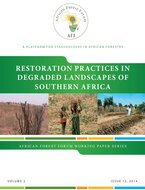The highest deforestation and forest degradation rates in Africa occur in the dry forests and woodlands where the pressure for land is continuously increasing, poverty is rampant, livelihood options are few, and climate change effects are severe and expected to become even more severe. In addition, land and forest tenure and rights of access to forest and woodland resources are either not clearly defined or non-existent to many people. Restoration of degraded forest and tree resources as well as woodland areas, therefore, may contribute to both peoples livelihoods and environmental quality. An assessment was conducted in some countries in Southern Africa in order to document local experiences in restoring degraded lands, forest and tree resources as well as woodland areas. The specific objectives of the study were to:
assess ways and experiences farmers and other stakeholders have and are using to rehabilitate degraded lands and forest and tree resources in woodlands and savannahs in Southern Africa;
identify and describe the technologies and practices that have been very successful in rehabilitating degraded lands as well as forest and tree resources in Southern Africa and the conditions for their success;
evaluate the extent to which such successful technologies and practices and their prerequisite conditions can be up-scaled in woodlands and savannahs of Southern Africa.
Both published and grey literature was accessed to source data and/or information on land degradation and technologies used for rehabilitation/restoration in countries of Southern Africa. Literature review was supplemented by field visits in Malawi, a country deemed to have serious land degradation due to high population pressure with limited land for agricultural expansion.

